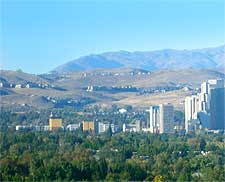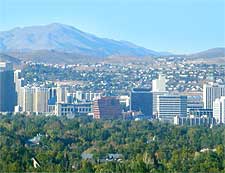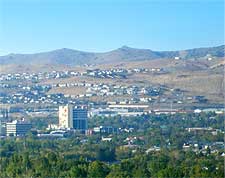Reno History Facts and Timeline
(Reno, Nevada - NV, USA)

Known for easy divorce and gambling, the history of Reno is certainly quirky. Much like
Las Vegas, which is also sat in the middle of nowhere, Reno was only established in the late 1860s, with its early history involving mining, gold, gambling and the ups and downs that went with it.
Like Vegas, this lively city was also once known as 'Sin City' for its brothels and underground gambling.
Gold and the Railroad
After gold was discovered in Virginia City (to the south of Reno) in the mid-1800s, Charles Fuller decided to construct a bridge over the Truckee River, charging a toll to cross. Myron Lake bought the bridge and some land not long before the Central Pacific Railroad came through the region. After greasing the palm of railroad planners (namely Charles Crocker) with land deeds, the town of 'Lake's Crossing' was incorporated and the site of Reno was established in the year of 1868, soon taking its name after Civil War hero, General Jesse Reno.

One of the most historic buildings in the city, the Lake Mansion dates to this time, being built in 1877. Originally situated on California Street, it now resides on Kietzke Lane and houses a museum. The University of Nevada (the state's oldest university) also hails from around this time. In addition to the founding of Reno, nearby Fallon also came about, with water being diverted for farming in the Fallon area as part of the Newlands Reclamation Project. Newlands Home, the former mansion of a US senator, is of great note and serves as a National Historic Landmark.
Reno Divorce and Gambling
Reno made history and headlines in the 1920s for its divorce trade, where couples looking to divorce and / or remarry would board at Nystrom House. The Riverside Hotel was later built in 1927 by architect Frederic DeLongchamps and became an instant hit. Highways 40 and 50 (the Victory and Lincoln highways) were completed this same year.
The famed Reno Arch, which was erected in 1926 for the Transcontinental Highways Exposition, held in 1927, was kept on after as a gateway to the town. A slogan was sought from the citizens, with
Sacramento local GA Burns winning this competition with 'The Biggest Little City in the World'. Gambling was legalized in 1931 and several casinos went up, including the Palace and the Bank Club, with the latter becoming a huge hit and the biggest casino that the world had ever seen.

The first high-rise hotel casino came about in 1947 in the form of the Mapes Hotel (demolished in 2000), which became the template of future similar establishments. The 1950s boomed, although two huge natural gas explosions in 1957 killed two people and destroyed many downtown buildings. The site of Century Riverside (at Sierra Street) endured the first explosion, with the second explosion taking place at Palladio.
Latter Day Reno
Business slowed towards the end of the 20th century, so Reno has looked to other means of income with the building of an entertainment district and the hosting of big international events. There are further attractions out of town, with new casinos including the glitzy Grand Sierra, the Atlantis and the Peppermill Resort having been erected away from the main core of Virginia Street.
The history of Reno can be sought in a number of museums, including the nearby Great Basin Adventure historical theme park, the Wilbur May Museum at the Rancho San Rafael Park, and the Museum of the Nevada Historical Society at the University of Nevada. Contrary to popular thinking, prostitution is not legal in Reno, or Las Vegas, although certain small counties in Nevada have legalised this and do feature registered brothels.
 Known for easy divorce and gambling, the history of Reno is certainly quirky. Much like Las Vegas, which is also sat in the middle of nowhere, Reno was only established in the late 1860s, with its early history involving mining, gold, gambling and the ups and downs that went with it.
Known for easy divorce and gambling, the history of Reno is certainly quirky. Much like Las Vegas, which is also sat in the middle of nowhere, Reno was only established in the late 1860s, with its early history involving mining, gold, gambling and the ups and downs that went with it. One of the most historic buildings in the city, the Lake Mansion dates to this time, being built in 1877. Originally situated on California Street, it now resides on Kietzke Lane and houses a museum. The University of Nevada (the state's oldest university) also hails from around this time. In addition to the founding of Reno, nearby Fallon also came about, with water being diverted for farming in the Fallon area as part of the Newlands Reclamation Project. Newlands Home, the former mansion of a US senator, is of great note and serves as a National Historic Landmark.
One of the most historic buildings in the city, the Lake Mansion dates to this time, being built in 1877. Originally situated on California Street, it now resides on Kietzke Lane and houses a museum. The University of Nevada (the state's oldest university) also hails from around this time. In addition to the founding of Reno, nearby Fallon also came about, with water being diverted for farming in the Fallon area as part of the Newlands Reclamation Project. Newlands Home, the former mansion of a US senator, is of great note and serves as a National Historic Landmark. The first high-rise hotel casino came about in 1947 in the form of the Mapes Hotel (demolished in 2000), which became the template of future similar establishments. The 1950s boomed, although two huge natural gas explosions in 1957 killed two people and destroyed many downtown buildings. The site of Century Riverside (at Sierra Street) endured the first explosion, with the second explosion taking place at Palladio.
The first high-rise hotel casino came about in 1947 in the form of the Mapes Hotel (demolished in 2000), which became the template of future similar establishments. The 1950s boomed, although two huge natural gas explosions in 1957 killed two people and destroyed many downtown buildings. The site of Century Riverside (at Sierra Street) endured the first explosion, with the second explosion taking place at Palladio.